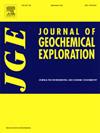Isolation and identification of anaerobic molybdenum(VI)-reducing bacteria in molybdenum mine sediments in Korea
IF 3.4
2区 地球科学
Q1 GEOCHEMISTRY & GEOPHYSICS
引用次数: 0
Abstract
This study was conducted to isolate and identify anaerobic molybdenum(VI)-reducing bacteria from sediments and soils collected from molybdenum mine areas in Korea. Molybdenum, a trace element vital for biological systems, can pose environmental risks when present in high concentrations, particularly in mining areas. Soil and sediment samples were collected, and the physicochemical properties including pH and metal content were analyzed. Two bacterial strains, identified as Klebsiella aerogenes and Klebsiella oxytoca, were isolated and exhibited significant molybdenum(VI) reduction under anaerobic conditions, reducing over 90 % of the molybdenum within 72 h at an initial concentration of 15 mM. The study further explored the effects of alternative electron acceptors and donors, revealing that nitrate and sulfate did not inhibit Mo(VI) reduction, while acetate had little effect. The reduction likely occurred via fermentative processes rather than respiratory reduction, as evidenced by the absence of oxygen consumption, the preferential use of glucose as an electron donor, and the lack of competition from alternative electron acceptors such as nitrate and sulfate under anaerobic conditions. These findings suggest that microbial Mo(VI) reduction in mining environments could play a critical role in the geochemical cycling of molybdenum and provide a foundational basis for developing bioremediation strategies specifically tailored for mining-affected ecosystems.
韩国钼矿沉积物中厌氧钼(VI)还原菌的分离与鉴定
本研究从韩国钼矿区收集的沉积物和土壤中分离和鉴定厌氧钼(VI)还原细菌。钼是一种对生物系统至关重要的微量元素,在高浓度存在时,特别是在矿区,可能会造成环境风险。采集土壤和沉积物样品,分析其理化性质,包括pH值和金属含量。分离出两株产气克雷伯菌和氧化克雷伯菌,在厌氧条件下表现出明显的钼(VI)还原作用,在初始浓度为15 mM的条件下,72 h内钼还原率超过90%。研究进一步探讨了不同电子受体和给体对钼还原的影响,发现硝酸盐和硫酸盐对钼(VI)还原没有抑制作用,而醋酸盐对钼(VI)还原作用很小。这种还原可能是通过发酵过程发生的,而不是呼吸还原,这一点可以从缺氧、葡萄糖作为电子供体的优先使用以及在厌氧条件下缺乏其他电子受体(如硝酸盐和硫酸盐)的竞争中得到证明。这些结果表明,采矿环境中微生物Mo(VI)的减少可能在钼的地球化学循环中发挥关键作用,并为开发针对采矿影响生态系统的生物修复策略提供了基础依据。
本文章由计算机程序翻译,如有差异,请以英文原文为准。
求助全文
约1分钟内获得全文
求助全文
来源期刊

Journal of Geochemical Exploration
地学-地球化学与地球物理
CiteScore
7.40
自引率
7.70%
发文量
148
审稿时长
8.1 months
期刊介绍:
Journal of Geochemical Exploration is mostly dedicated to publication of original studies in exploration and environmental geochemistry and related topics.
Contributions considered of prevalent interest for the journal include researches based on the application of innovative methods to:
define the genesis and the evolution of mineral deposits including transfer of elements in large-scale mineralized areas.
analyze complex systems at the boundaries between bio-geochemistry, metal transport and mineral accumulation.
evaluate effects of historical mining activities on the surface environment.
trace pollutant sources and define their fate and transport models in the near-surface and surface environments involving solid, fluid and aerial matrices.
assess and quantify natural and technogenic radioactivity in the environment.
determine geochemical anomalies and set baseline reference values using compositional data analysis, multivariate statistics and geo-spatial analysis.
assess the impacts of anthropogenic contamination on ecosystems and human health at local and regional scale to prioritize and classify risks through deterministic and stochastic approaches.
Papers dedicated to the presentation of newly developed methods in analytical geochemistry to be applied in the field or in laboratory are also within the topics of interest for the journal.
 求助内容:
求助内容: 应助结果提醒方式:
应助结果提醒方式:


